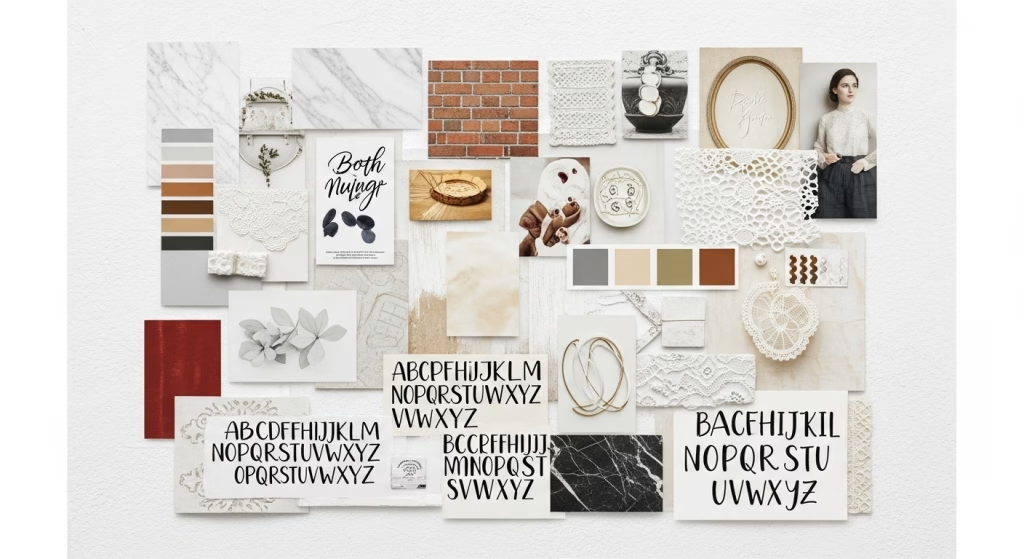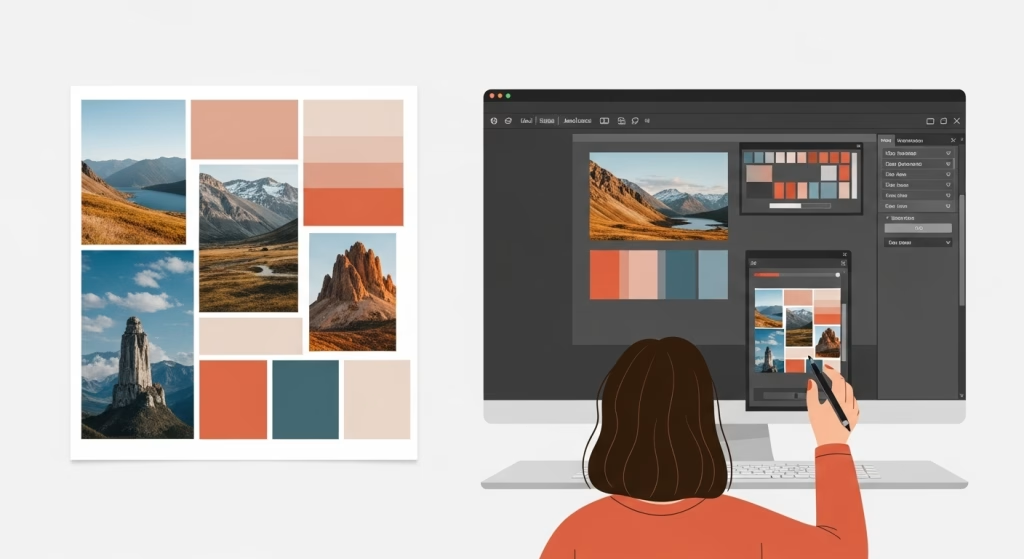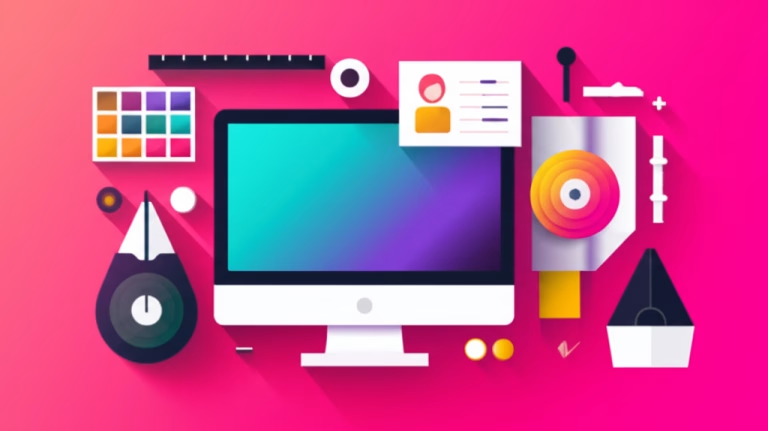Spark Your Creativity Daily: Unlock Fresh Visions with Daily Design Inspiration
Ever feel like your creative well has run dry? Staring at a blank screen, waiting for that brilliant idea to strike, but it just… doesn’t? You’re not alone. Every designer, from seasoned pros to enthusiastic beginners, faces moments of creative stagnation. But what if you could cultivate a consistent flow of fresh ideas, transforming your daily routine into a wellspring of Daily Design Inspiration?
This article is your guide to building a vibrant creative habit, helping you not just find inspiration, but actively seek, internalize, and apply it to your graphic design, web design, visual identity, and social media projects. We’ll explore how to consciously expand your aesthetic repertoire and consistently generate ideas that elevate your work, using the powerful E.E.T.A. (Experience, Expertise, Transparency, and Authority) method. Get ready to unlock new perspectives and infuse every project with fresh, original vision.
Table of Contents
The Power of Intentional Inspiration: Why it Matters
In a world overflowing with visual content, simply browsing social media won’t consistently spark groundbreaking ideas. True creative growth comes from actively seeking and consciously processing inspiration. When you engage in intentional inspiration, you train your eye to see possibilities everywhere, transforming passive consumption into active learning. This conscious approach helps you avoid generic solutions and develop a unique aesthetic that truly stands out.
For beginners, understanding this distinction is crucial. It’s the difference between mimicking trends and understanding the underlying principles that make them effective. By proactively engaging with diverse visual stimuli, you build a rich internal library of ideas, ready to be drawn upon when a new project arises. This conscious cultivation of your creative input is the first step towards consistent innovation and a more fulfilling design practice.
Embodying Inspiration: The E.E.T.A. Method for Designers
The E.E.T.A. method isn’t just for business; it’s a powerful framework for integrating Daily Design Inspiration into your creative life, ensuring your work is authentic, informed, and impactful.
Experience: Broaden Your Creative Horizons
Your ability to generate fresh ideas is directly linked to the richness of your experiences. Don’t limit your inspiration to design blogs. Look at art, explore nature, visit local markets, observe architecture, or even pay attention to the typography on everyday packaging. Each new exposure is a potential seed for a design idea. The more diverse your visual input, the more unique your output will be. This continuous absorption of new visual stimuli builds your aesthetic perception.
Expertise: Deepen Your Visual Understanding
It’s not enough to just see; you must understand. As you encounter inspiring visuals, delve deeper into *why* they work. What colors, shapes, or compositions were used? What emotions do they evoke? This analytical approach transforms raw inspiration into actionable knowledge. Your growing expertise in design principles (like hierarchy, contrast, and balance) allows you to deconstruct complex visuals and apply their essence to your own projects. This is where observation turns into learned skill.
Transparency: Share Your Creative Journey
Being transparent about your inspiration sources and creative process fosters authenticity and builds trust. Don’t be afraid to show your mood boards, initial sketches, or the references that sparked an idea. This openness not only demystifies your work but also invites collaboration and feedback. When you share your journey, you demonstrate a willingness to learn and grow, reinforcing your commitment to the craft.
Authority: Own Your Inspired Creations
As you consistently draw from diverse experiences, deepen your expertise, and share your transparent process, you naturally build authority in your creative voice. This authority isn’t about arrogance; it’s about confidence in your ability to generate and execute original ideas. When you present your work, you can articulate the thoughtful journey from initial inspiration to final design, demonstrating that your solutions are intentional and well-considered. This empowers you to stand firm in your creative vision.
Curating Your Visual Universe: References and Moodboards
To effectively harness Daily Design Inspiration, you need a system for collecting and organizing your visual discoveries. This is where references and mood boards become indispensable tools.
Start by actively saving anything that sparks your interest. Platforms like Pinterest are excellent for digital “swipe files,” allowing you to categorize images, color palettes, and typographic styles. Use sites like Behance and Dribbble not just for finished work, but to study how other designers present their concepts and processes. Beyond digital, keep a physical sketchbook or a folder for tear-sheets from magazines, fabric swatches, or even interesting packaging designs.

A mood board is more than just a collection; it’s a visual narrative of your project’s aesthetic. Arrange your collected elements to tell a story about the desired mood, tone, and style. This helps you identify recurring themes, refine your vision, and communicate your concept clearly to clients or collaborators before you even begin the actual design phase. It’s a living document that evolves with your ideas, serving as your visual compass throughout the creative process.
Translating Inspiration into Action: Applying Ideas Daily
The true test of inspiration is its application. How do you take that spark from a daily observation and transform it into a tangible design? It starts with intentional practice and a willingness to experiment.
For instance, if you’re working on a social media post, think about a color combination you saw on a street art mural this morning. Can you translate that energy into your graphic? Or perhaps a unique layout from a magazine advertisement could inspire a new approach to a web banner. Don’t be afraid to combine elements from seemingly unrelated sources. This cross-pollination often leads to the most original and compelling results.

Start small. Instead of a full rebrand, try applying a new typographic style to a single headline. Experiment with a different visual texture in a background. The key is to iterate and refine. Your first attempt might not be perfect, but each iteration brings you closer to a unique and effective solution. This continuous cycle of inspiration, application, and refinement is how you truly build your creative muscle and develop a distinct personal style.
Sources for Your Daily Design Inspiration Journey
Inspiration is truly everywhere once you train your eye to see it. Here are some diverse avenues to explore for your Daily Design Inspiration:
Everyday Life & Analog Worlds
Look beyond your screen. Observe the patterns in nature, the typography on old signs, the color palettes in a bustling market, or the composition of a well-arranged storefront. Carry a small notebook or use your phone camera to capture these moments. How do these real-world elements make you feel? What story do they tell? This practice of mindful observation enriches your visual vocabulary in a way digital feeds cannot.
Digital Realms & Curated Galleries
Of course, the internet remains a powerhouse for inspiration. Beyond the well-known platforms, explore niche design blogs, online art galleries, and communities focused on specific styles (e.g., brutalism, Swiss design, vintage aesthetics). Subscribe to newsletters from design agencies and artists you admire. Dive into the archives of digital art history. Websites like It’s Nice That offer a continuous stream of fresh, diverse creative work across various disciplines.
Historical & Cultural Contexts
Delve into art history, cultural movements, and traditional crafts. Understanding the origins and evolution of visual styles can provide a deeper appreciation and endless inspiration. Study ancient symbols, medieval illuminated manuscripts, Art Deco architecture, or traditional textile patterns. This historical context enriches your understanding of design and offers timeless references that transcend fleeting trends.
Embrace Experimentation and Break the Mold
True creative growth lies beyond your comfort zone. Once you’ve gathered inspiration and understood its elements, dare to experiment. Combine a color palette from a Renaissance painting with a minimalist web layout. Blend a brutalist typeface with soft, organic shapes. The magic often happens at the intersection of unexpected combinations.
Don’t be afraid to make “mistakes.” Each unsuccessful experiment is a valuable lesson, guiding you closer to innovative solutions. Challenge yourself to solve a design problem in three completely different visual styles. This continuous process of exploration, iteration, and thoughtful risk-taking is essential for developing a truly unique and authoritative creative voice that continually generates Daily Design Inspiration.
Conclusion: Your Canvas Awaits Fresh Visions
You now hold the keys to a limitless well of Daily Design Inspiration. We’ve explored why conscious inspiration is paramount for creative growth, how the E.E.T.A. method empowers your journey, and practical ways to collect, organize, and apply diverse visual stimuli. Remember, inspiration isn’t a passive gift; it’s an active pursuit, a muscle that strengthens with consistent exercise.
Embrace the world around you as your endless mood board. Dare to experiment with new styles and unexpected combinations. Let every observation fuel a fresh idea, and every project be an opportunity to apply your evolving aesthetic vision. Your journey as a designer is a continuous dance between learning, creating, and inspiring. Keep exploring, keep experimenting, and watch as your designs transform into truly captivating expressions of your unique creative spirit.
Recommended Reading:
– Visual Discovery: Train Your Creative Eye – Learn how to sharpen your observational skills and find inspiration in unexpected places, a perfect complement to your daily creative routine.



